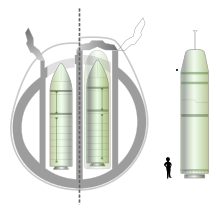Submarine-launched ballistic missile

Submarine-launched ballistic missiles or SLBMs are ballistic missiles delivering nuclear weapons that are launched from submarines. Modern variants usually deliver multiple independently targetable reentry vehicles (MIRVs) each of which carries a warhead and allows a single launched missile to strike several targets.
History

As early as 1934, H. G. Wells predicted, in his The Shape of Things to Come, the use of submarines carrying "long-range air torpedoes with directional apparatus". Though he envisaged these as carrying chemical rather than nuclear warheads, he grasped the far reaching strategic implications. "The smallest of these raiders carried enough of such stuff to 'prepare' about eight hundred square miles of territory; it could have turned London or New York into a cityful of distorted corpses. These vessels made London vulnerable to Japan, Tokyo vulnerable to Dublin; they abolished the last corners of safety in the world."
The first successful tests of a submarine-based launch platform were by German submarines in World War II using a submarine towed launch platform. These and other early SLBM systems required vessels to be surfaced when they fired missiles, but after World War II, launch systems were quickly adapted to allow underwater launching, with the United States making the first underwater launch of a Polaris SLBM.
Ballistic missile submarines have been of great strategic importance for the USA and Russia since the start of the Cold War, as they can hide from reconnaissance satellites and fire their nuclear weapons with virtual impunity. This makes them immune to a First Strike directed against nuclear forces, allowing each side to maintain the capability to launch a devastating retaliatory strike, even if all land-based missiles have been destroyed. This relieves each side of the necessity to adopt a launch on warning posture, with its grave attendant risk of accidental nuclear war. Additionally, the deployment of highly accurate missiles on ultra-quiet submarines allows an attacker to sneak up close to the enemy coast and launch a missile on a depressed trajectory - a very close range attack which will hit its target in a matter of minutes, thus opening the possibility of a decapitation strike.
Types of SLBMs

Specific types of SLBMs (current & past) include:
- India:

- Sagarika - Undergoing integration with ATV.
- Agni-III SL - Under development.
- Soviet Union/Russia:


- SS-N-4 R-13
- SS-N-5 "Sark",R-21
- SS-N-6 "Serb",R-27
- SS-N-8 "Sawfly",R-29
- SS-N-17 "Snipe",R-31
- SS-N-18 "Stingray", R-29,RSM-50
- R-39 missile, SS-N-20 "Sturgeon", RSM-52
- R-29RM Shtil "Skiff", R-29RM,RSM-54
- SS-NX-30, 3M30,R-30,RSM-56
- US and UK:


- Polaris missile
- Poseidon missile
- Trident missile - current
Types of SSBNs
Specific types of ballistic missile submarines (SSBNs) include:
- James Madison class - former, US
- Benjamin Franklin class - former, US
- Triomphant class - current, France
- Redoutable class - former, France
- Ohio class - current, US
- Resolution class - former, UK
- Vanguard class - current, UK
- Type 092 (Xia class) submarine - current, China
- Type 094 (Jin class) submarine - Under development, China[1]
- Type 096 - Planned, China
- Advanced Technology Vessel - Under development (2010), India
- List of NATO reporting names for ballistic missile submarines - current and former, Russia
References
See also
- ICBM
- nuclear navy
- nuclear warfare
- nuclear strategy
- submarine
- submarine-launched missile
- vertical launching system
External links
- Video showing the launch of a Trident SLBM.
- Estimated Strategic Nuclear Weapons Inventories (September 2004)
- Sagarika Missile
- India ready to join elite N-strike club
- India test fires K-15,a 700 km SLBM
- R-11 SLBM
